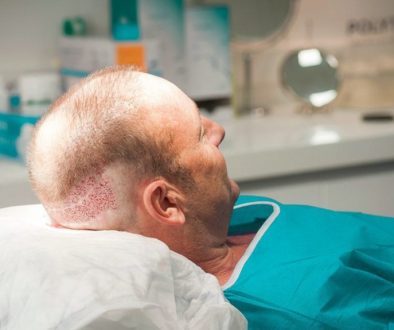Why should a doctor measure miniaturization in the donor area before recommending a hair transplant?
 Normally, the donor area contains hairs of very uniform diameter (called terminal hairs). In androgenetic hair loss, the action of DHT causes some of these terminal hairs to decrease in diameter and in length until they eventually disappear (a process referred to as “miniaturization”). These changes are seen initially as thinning and eventually lead to complete baldness in the involved areas. These changes affect the areas that normally bald in genetic hair loss, namely the front and top of the scalp and the crown.
Normally, the donor area contains hairs of very uniform diameter (called terminal hairs). In androgenetic hair loss, the action of DHT causes some of these terminal hairs to decrease in diameter and in length until they eventually disappear (a process referred to as “miniaturization”). These changes are seen initially as thinning and eventually lead to complete baldness in the involved areas. These changes affect the areas that normally bald in genetic hair loss, namely the front and top of the scalp and the crown.
However, miniaturization can also affect the donor or permanent regions of the scalp (where the hair is taken from during a hair transplant). If the donor area shows thinning, particularly when a person is young, then a hair transplant will not be successful because the transplanted hair would continue to thin in the new area and eventually disappear. It is important to realize that just because hair is transplanted to another area, that doesn’t make it permanent – it must have been permanent in the area of the scalp it initially came from.
Unfortunately, in its early stages, miniaturization cannot be seen with the naked eye. To detect early miniaturization a doctor must use a densitometer, or an equivalent instrument, that magnifies the surface of the scalp at least 20-30 times. This enables the doctor to see early changes in the diameter of the hairs that are characteristic of miniaturization. If hairs of varying diameter are noted (besides the very fine vellous hairs that normally occur in the scalp), it means that the hair is being affected by DHT and the donor area is not truly permanent.
In this situation, a person should not be scheduled for hair transplantation. If the densitometry reading is not clear, i.e. the changes are subtle and the doctor is not sure, then the decision to have surgery should be postponed. By waiting a few years, it will be easier to tell if the donor area is stable. Having hair transplant surgery when the donor area is miniaturizing can be a major problem for a patient, since not only will the transplanted hair eventually disappear, but the scar(s) in the donor may eventually become visible. This problem will occur with both follicular unit transplantation (FUT) and follicular unit excision (formerly follicular unit extraction) (FUE).
By Robert M. Bernstein, Founder of Bernstein Medical
Technorati Tags: DHT, baldness, hair transplant, transplanted hair, hair transplantation, hair transplant surgery



